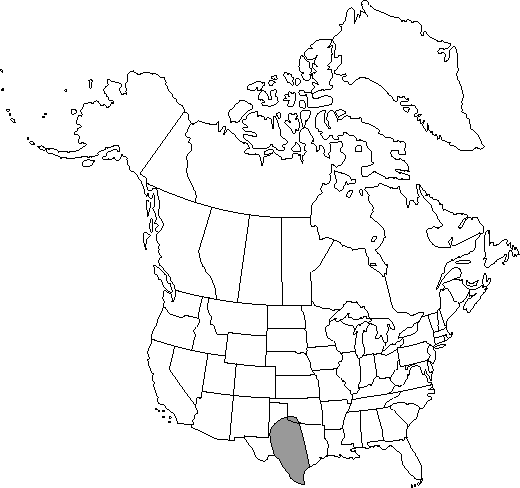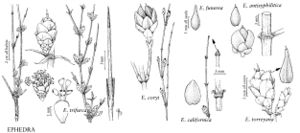Difference between revisions of "Ephedra antisyphilitica"
Sér. 6, Sci. Math., Seconde Pt. Sci. Nat. 5(2): 29. 1846.
FNA>Volume Importer |
imported>Volume Importer |
||
| (7 intermediate revisions by 2 users not shown) | |||
| Line 11: | Line 11: | ||
|name=Ephedra antisyphilitica var. brachycarpa | |name=Ephedra antisyphilitica var. brachycarpa | ||
|authority=Cory | |authority=Cory | ||
| − | }}{{Treatment/ID/Synonym | + | |rank=variety |
| + | }} {{Treatment/ID/Synonym | ||
|name=Ephedra occidentalis | |name=Ephedra occidentalis | ||
|authority=E. L. Reed | |authority=E. L. Reed | ||
| − | }}{{Treatment/ID/Synonym | + | |rank=species |
| + | }} {{Treatment/ID/Synonym | ||
|name=Ephedra texana | |name=Ephedra texana | ||
| − | |authority= | + | |authority= |
| + | |rank=species | ||
}} | }} | ||
|hierarchy=Ephedraceae;Ephedra;Ephedra antisyphilitica | |hierarchy=Ephedraceae;Ephedra;Ephedra antisyphilitica | ||
| Line 25: | Line 28: | ||
}}<!-- | }}<!-- | ||
| − | --><span class="statement" id="st- | + | --><span class="statement" id="st-undefined" data-properties=""><b>Shrubs </b>erect or spreading, 0.25–1 m. <b>Bark</b> gray, slightly cracked and irregularly fissured. <b>Branches</b> alternate or whorled, rigid, angle of divergence about 45°. <b>Twigs</b> green, becoming yellow-green with age, glaucous, not viscid, with numerous longitudinal grooves; internodes 2–5 cm. <b>Terminal</b> buds conic, 1–3 mm, apex obtuse. <b>Leaves</b> opposite, 1–3 mm, connate to 2/3–7/8 their length; bases thickened, brown, completely deciduous; apex obtuse. <b>Pollen</b> cones 1–2 at node, lance-ellipsoid, 5–8 mm, sessile to nearly sessile; bracts opposite, 5–8 pairs, pale green to red, obovate, 2–4 × 2–3 mm, membranous, connate at base; bracteoles slightly exceeding bracts; sporangiophores 4–5 mm, 1/2 exserted, with 4–6 sessile to very short-stalked (less than 1 mm) microsporangia. <b>Seed</b> cones 1–2 at node, ellipsoid, 6–12 mm, sessile to nearly sessile; bracts opposite, 4–6 pairs, ovate, 5–7 × 5–10 mm, connate to 1/8–7/8 their length, inner pairs becoming fleshy and red. <b>Seeds</b> 1(–2), ellipsoid, 6–9 × 2–4 mm, light brown to chestnut, smooth.</span><!-- |
-->{{Treatment/Body | -->{{Treatment/Body | ||
| + | |phenology=Coning March–April. | ||
|habitat=Arid soils and rocky slopes | |habitat=Arid soils and rocky slopes | ||
|elevation=100–1200 m | |elevation=100–1200 m | ||
|distribution=Okla.;Tex.;Mexico in Nuevo León and San Luis Potosí. | |distribution=Okla.;Tex.;Mexico in Nuevo León and San Luis Potosí. | ||
| − | |discussion=<p>Mexican populations of Ephedra antisyphilitica are disjunct from those in Texas.</p> | + | |discussion=<p>Mexican populations of <i>Ephedra antisyphilitica</i> are disjunct from those in Texas.</p> |
|tables= | |tables= | ||
|references= | |references= | ||
| Line 40: | Line 44: | ||
-->{{#Taxon: | -->{{#Taxon: | ||
name=Ephedra antisyphilitica | name=Ephedra antisyphilitica | ||
| − | |||
|authority=Berlandier ex C. A. Meyer | |authority=Berlandier ex C. A. Meyer | ||
|rank=species | |rank=species | ||
| Line 47: | Line 50: | ||
|basionyms= | |basionyms= | ||
|family=Ephedraceae | |family=Ephedraceae | ||
| + | |phenology=Coning March–April. | ||
|habitat=Arid soils and rocky slopes | |habitat=Arid soils and rocky slopes | ||
|elevation=100–1200 m | |elevation=100–1200 m | ||
| Line 54: | Line 58: | ||
|publication year=1846 | |publication year=1846 | ||
|special status= | |special status= | ||
| − | |source xml=https:// | + | |source xml=https://bitbucket.org/aafc-mbb/fna-data-curation/src/2e0870ddd59836b60bcf96646a41e87ea5a5943a/coarse_grained_fna_xml/V2/V2_551.xml |
|genus=Ephedra | |genus=Ephedra | ||
|species=Ephedra antisyphilitica | |species=Ephedra antisyphilitica | ||
| − | |||
| − | |||
| − | |||
| − | |||
| − | |||
| − | |||
| − | |||
| − | |||
| − | |||
| − | |||
| − | |||
| − | |||
| − | |||
| − | |||
| − | |||
| − | |||
| − | |||
| − | |||
| − | |||
| − | |||
| − | |||
| − | |||
| − | |||
| − | |||
| − | |||
| − | |||
| − | |||
| − | |||
| − | |||
| − | |||
| − | |||
| − | |||
| − | |||
| − | |||
| − | |||
| − | |||
| − | |||
| − | |||
| − | |||
| − | |||
| − | |||
| − | |||
| − | |||
| − | |||
| − | |||
| − | |||
| − | |||
| − | |||
| − | |||
| − | |||
| − | |||
| − | |||
| − | |||
}}<!-- | }}<!-- | ||
-->[[Category:Treatment]][[Category:Ephedra]] | -->[[Category:Treatment]][[Category:Ephedra]] | ||
Latest revision as of 21:24, 5 November 2020
Shrubs erect or spreading, 0.25–1 m. Bark gray, slightly cracked and irregularly fissured. Branches alternate or whorled, rigid, angle of divergence about 45°. Twigs green, becoming yellow-green with age, glaucous, not viscid, with numerous longitudinal grooves; internodes 2–5 cm. Terminal buds conic, 1–3 mm, apex obtuse. Leaves opposite, 1–3 mm, connate to 2/3–7/8 their length; bases thickened, brown, completely deciduous; apex obtuse. Pollen cones 1–2 at node, lance-ellipsoid, 5–8 mm, sessile to nearly sessile; bracts opposite, 5–8 pairs, pale green to red, obovate, 2–4 × 2–3 mm, membranous, connate at base; bracteoles slightly exceeding bracts; sporangiophores 4–5 mm, 1/2 exserted, with 4–6 sessile to very short-stalked (less than 1 mm) microsporangia. Seed cones 1–2 at node, ellipsoid, 6–12 mm, sessile to nearly sessile; bracts opposite, 4–6 pairs, ovate, 5–7 × 5–10 mm, connate to 1/8–7/8 their length, inner pairs becoming fleshy and red. Seeds 1(–2), ellipsoid, 6–9 × 2–4 mm, light brown to chestnut, smooth.
Phenology: Coning March–April.
Habitat: Arid soils and rocky slopes
Elevation: 100–1200 m
Distribution

Okla., Tex., Mexico in Nuevo León and San Luis Potosí.
Discussion
Mexican populations of Ephedra antisyphilitica are disjunct from those in Texas.
Selected References
None.
